A) 1.0 C
B) 1000 C
C) 9.6 × 107 C
D) 6.0 × 1026 C
E) 6.0 × 1023 C
G) B) and E)
Correct Answer

verified
Correct Answer
verified
Multiple Choice
A particle of charge +2q is placed at the origin and particle of charge -q is placed on the x-axis at x = 2a.Where on the x-axis can a third positive charge be placed so that the net electric force on it is zero?
A) 3.4a
B) 6.8a
C) 8.6a
D) 9.3a
E) 1.0a
G) None of the above
Correct Answer

verified
Correct Answer
verified
Multiple Choice
Two identical small charged spheres are a certain distance apart,and each one initially experiences an electrostatic force of magnitude F due to the other.With time,charge gradually diminishes on both spheres by leaking off.When each of the spheres has lost half its initial charge,what will be the magnitude of the electrostatic force on each one?
A) 1/16 F
B) 1/8 F
C) 1/4 F
D) 1/2 F
E) 1/ ![]() F
F
G) A) and E)
Correct Answer

verified
Correct Answer
verified
Multiple Choice
A proton is placed in an electric field of intensity 800 N/C.What are the magnitude and direction of the acceleration of the proton due to this field? (e = 1.60 × 10-19 C,mproton = 1.67 × 10-27 kg)
A) 7.66 × ![]() m/
m/![]() opposite to the electric field
opposite to the electric field
B) 7.66 × ![]() m/
m/![]() opposite to the electric field
opposite to the electric field
C) 7.66 × ![]() m/
m/![]() in the direction of the electric field
in the direction of the electric field
D) 76.6 × ![]() m/
m/![]() opposite to the electric field
opposite to the electric field
E) 76.6 × ![]() m/
m/![]() in the direction of the electric field
in the direction of the electric field
G) B) and C)
Correct Answer

verified
Correct Answer
verified
Multiple Choice
Two stationary point charges q1 and q2 are shown in the figure along with a sketch of some field lines representing the electric field produced by them.What can you deduce from the sketch? 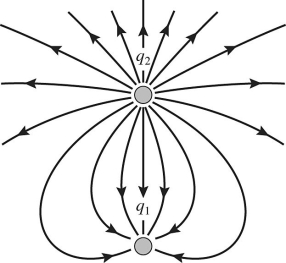
A) q1 is negative and q2 is positive;the magnitudes are equal.
B) q1 and q2 have the same sign;the magnitudes are equal.
C) q1 is positive and q2 is negative;the magnitude of q1 is greater than the magnitude of q2.
D) q1 is negative and q2 is positive;the magnitude of q1 is less than the magnitude of q2.
E) q1 and q2 have the same sign;the magnitude of q1 is greater than the magnitude of q2.
G) A) and C)
Correct Answer

verified
Correct Answer
verified
Multiple Choice
A negatively-charged plastic rod is brought close to (but does not touch) a neutral metal sphere that is connected to ground.After waiting a few seconds,the ground connection is removed (without touching the sphere) ,and after that the rod is also removed.The sphere is now
A) negatively charged.
B) positively charged.
C) neutral.
E) All of the above
Correct Answer

verified
Correct Answer
verified
Multiple Choice
Four point charges of equal magnitudes but with varying signs are arranged on three of the corners and at the center of the square of side d as shown in the figure.Which one of the arrows shown represents the net force acting on the center charge? 
A) A
B) B
C) C
D) D
F) B) and C)
Correct Answer

verified
Correct Answer
verified
Multiple Choice
A proton is located at the point (x = 1.0 nm,y = 0.0 nm) and an electron is located at the point (x=0.0nm, y= 4.0nm) . Find the magnitude of the electrostatic force that each one exerts on the other.(k = 1/4πε0 = 9.0 × 109 N ∙ m2/C2,e = 1.6 × 10-19C)
A) 1.4 × 10-11 N
B) 5.3 × 10-18 N
C) 5.3 × 108 N
D) 5.9 × 10-15 N
F) B) and C)
Correct Answer

verified
Correct Answer
verified
Multiple Choice
What is the magnitude of the electric field 2.8 cm from a tiny object that carries an excess charge of -16 nC? (k = 1/4πε0 = 9.0 × 109 N ∙ m2/C2)
A) 180,000 N/C
B) 5100 N/C
C) 1.8 × 1014 N/C
D) -180,000 N/C
E) -5100 N/C
G) A) and B)
Correct Answer

verified
Correct Answer
verified
Multiple Choice
Two tiny beads,each of mass 3.2 g,carry equal-magnitude charges.When they are placed 6.4 cm apart and released in outer space,they begin to accelerate toward each other at 538 m/s2.What is the magnitude of the charge on each bead? (k = 1/4πε0 = 9.0 × 109 N ∙ m2/C2)
A) 510 nC
B) 44 nC
C) 1800 nC
D) 890 nC
E) 1300 nC
G) D) and E)
Correct Answer

verified
Correct Answer
verified
Multiple Choice
Which one of the arrows shown in the figure best represents the direction of the electric field between the two uniformly charged metal plates? 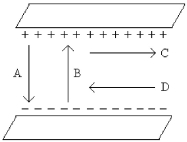
A) A
B) B
C) C
D) D
E) None of the above
G) B) and E)
Correct Answer

verified
Correct Answer
verified
Multiple Choice
Two point charges,Q1 and Q2,are separated by a distance R.If the magnitudes of both charges are doubled and their separation is also doubled,what happens to the electrical force that each charge exerts on the other one?
A) It increases by a factor of 2.
B) It increases by a factor of ![]() .
.
C) It is reduced by a factor of ![]() .
.
D) It increases by a factor of 4.
E) It remains the same.
G) C) and E)
Correct Answer

verified
Correct Answer
verified
Multiple Choice
Two 10¢ coins (dimes) carrying identical charges are lying 2.5 m apart on a table.If each of these coins experiences an electrostatic force of magnitude 2.0 N due to the other coin,how large is the charge on each coin? (k = 1/4πε0 = 9.0 × 109 N ∙ m2/C2)
A) 2.6 μC
B) 26 μC
C) 6.7 μC
D) 5.2 �μC
E) 52 μC
G) A) and B)
Correct Answer

verified
Correct Answer
verified
Multiple Choice
A small styrofoam ball of mass 0.120 g is placed in an electric field of 6000 N/C pointing downward.What excess charge must be placed on the ball for it to remain suspended in the field?
A) -16.0 nC
B) -18.0 nC
C) -57.2 nC
D) -125 nC
E) -196 nC
G) C) and D)
Correct Answer

verified
Correct Answer
verified
Multiple Choice
Two electrons are  Apart at closest approach.What is the magnitude of the maximum electric force that they exert on each other? (e = 1.60 × 10-19 C,k = 1/4πε0 = 9.0 109 N ∙ m2/C2)
Apart at closest approach.What is the magnitude of the maximum electric force that they exert on each other? (e = 1.60 × 10-19 C,k = 1/4πε0 = 9.0 109 N ∙ m2/C2)
A) 5.8 × 10-25 N
B) 2.3 × 1010 N
C) 2.3 N
D) 5.8 × 10-27 N
F) C) and D)
Correct Answer

verified
Correct Answer
verified
Multiple Choice
Four tiny charged particles (two having a charge +Q and two having a charge -Q) are distributed on the x- and y-axes as shown in the figure.Each charge is equidistant from the origin.In which direction is the net electric field at the point P on the y-axis? 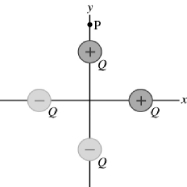
A) directly up (in the +y direction)
B) directly left (-x direction)
C) upwards and towards the left
D) upwards and towards the right
E) The net field is zero,so there is no direction.
G) C) and E)
Correct Answer

verified
Correct Answer
verified
Multiple Choice
As shown in the figure,three small charges are equally spaced on the arc of a circle that is centered at the charge Q,where Q = +23 nC and all the other quantities are accurate to two significant figures.What is the magnitude of the net electric force on the charge Q due to the other three charges? (k = 1/4πε0 = 9.0 × 109 N ∙ m2/C2) 
A) 2.6 × 10-4 N
B) 1.7 × 10-4 N
C) 2.1 × 10-4 N
D) 3.1 × 10-4 N
F) A) and D)
Correct Answer

verified
Correct Answer
verified
Multiple Choice
Four point charges Q of equal magnitude and sign are arranged on three of the corners of the square of side d as shown in the figure Which one of the arrows shown represents the net force acting on the charge at the upper right hand corner of the square? 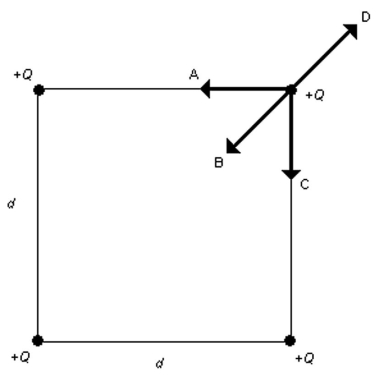
A) A
B) B
C) C
D) D
F) A) and B)
Correct Answer

verified
Correct Answer
verified
Multiple Choice
A small 0.050-kg insulating sphere carries a charge of -60 μC and is hanging by a vertical silk thread from a fixed point in the ceiling.An external uniform vertical electric field is now applied.If the applied electric field has a magnitude of 3000 N/C and is directed downward,what is the tension in the silk thread? (k = 1/4πε0 = 9.0 × 109 N ∙ m2/C2)
A) 0.19 N
B) 0.31 N
C) 0.41 N
D) 0.52 N
E) 0.71 N
G) C) and E)
Correct Answer

verified
Correct Answer
verified
Multiple Choice
Three equal charges +Q are at three of the corners of a square of side d.A fourth charge +Q of equal magnitude is at the center of the square as shown in the figure Which one of the arrows shown represents the net force acting on the charge at the center of the square? 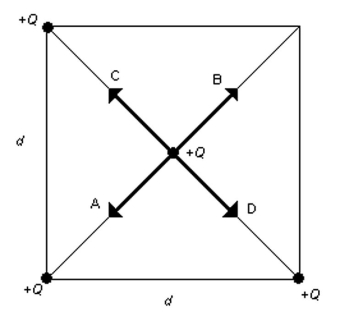
A) A
B) B
C) C
D) D
F) B) and C)
Correct Answer

verified
Correct Answer
verified
Showing 41 - 60 of 75
Related Exams